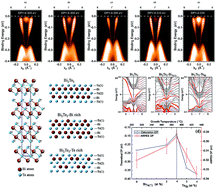Our official English website, www.x-mol.net, welcomes your
feedback! (Note: you will need to create a separate account there.)
Anti-site defect effect on the electronic structure of a Bi2Te3 topological insulator
RSC Advances ( IF 3.9 ) Pub Date : 2018-01-02 00:00:00 , DOI: 10.1039/c7ra08995c Pei-Yu Chuang,Shu-Hsuan Su,Cheong-Wei Chong,Yi-Fan Chen,Yu-Heng Chou,Jung-Chun-Andrew Huang,Wei-Chuan Chen,Cheng-Maw Cheng,Ku-Ding Tsuei,Chia-Hsin Wang,Yaw-Wen Yang,Yen-Fa Liao,Shih-Chang Weng,Jyh-Fu Lee,Yi-Kang Lan,Shen-Lin Chang,Chi-Hsuan Lee,Chih-Kai Yang,Hai-Lin Su,Yu-Cheng Wu
RSC Advances ( IF 3.9 ) Pub Date : 2018-01-02 00:00:00 , DOI: 10.1039/c7ra08995c Pei-Yu Chuang,Shu-Hsuan Su,Cheong-Wei Chong,Yi-Fan Chen,Yu-Heng Chou,Jung-Chun-Andrew Huang,Wei-Chuan Chen,Cheng-Maw Cheng,Ku-Ding Tsuei,Chia-Hsin Wang,Yaw-Wen Yang,Yen-Fa Liao,Shih-Chang Weng,Jyh-Fu Lee,Yi-Kang Lan,Shen-Lin Chang,Chi-Hsuan Lee,Chih-Kai Yang,Hai-Lin Su,Yu-Cheng Wu

|
Tuning the Fermi level (EF) in Bi2Te3 topological-insulator (TI) films is demonstrated on controlling the temperature of growth with molecular-beam epitaxy (MBE). Angle-resolved photoemission spectra (ARPES) reveal that EF of Bi2Te3 thin films shifts systematically with the growth temperature (Tg). The key role that a Bi-on-Te(1) (BiTe1) antisite defect plays in the electronic structure is identified through extended X-ray-absorption fine-structure (EXAFS) spectra at the Bi L3-edge. Calculations of electronic structure support the results of fitting the EXAFS, indicating that the variation of EF is due to the formation and suppression of BiTe1 that is tunable with the growth temperature. Our findings provide not only insight into the correlation between the defect structure and electronic properties but also a simple route to control the intrinsic topological surface states, which could be useful for applications in TI-based advanced electronic and spintronic devices.
中文翻译:

反位缺陷对Bi 2 Te 3拓扑绝缘体 电子结构的影响
通过控制分子束外延(MBE)的生长温度,证明了在Bi 2 Te 3拓扑绝缘体(TI)薄膜中调节费米能级(E F)。角度分辨光发射光谱(ARPES)表明,Bi 2 Te 3薄膜的E F随着生长温度(T g)而系统地移动。通过在Bi L 3处扩展的X射线吸收精细结构(EXAFS)光谱,确定了Bi-on-Te(1)(Bi Te1)反位缺陷在电子结构中的关键作用。-边缘。电子结构的计算支持拟合EXAFS的结果,表明E F的变化是由于Bi Te1的形成和抑制所致,Bi Te1随生长温度可调。我们的发现不仅提供了对缺陷结构与电子特性之间关系的深入了解,而且还提供了一种控制固有拓扑表面状态的简单途径,这对于在基于TI的先进电子和自旋电子器件中的应用可能是有用的。
更新日期:2018-01-02
中文翻译:

反位缺陷对Bi 2 Te 3拓扑绝缘体 电子结构的影响
通过控制分子束外延(MBE)的生长温度,证明了在Bi 2 Te 3拓扑绝缘体(TI)薄膜中调节费米能级(E F)。角度分辨光发射光谱(ARPES)表明,Bi 2 Te 3薄膜的E F随着生长温度(T g)而系统地移动。通过在Bi L 3处扩展的X射线吸收精细结构(EXAFS)光谱,确定了Bi-on-Te(1)(Bi Te1)反位缺陷在电子结构中的关键作用。-边缘。电子结构的计算支持拟合EXAFS的结果,表明E F的变化是由于Bi Te1的形成和抑制所致,Bi Te1随生长温度可调。我们的发现不仅提供了对缺陷结构与电子特性之间关系的深入了解,而且还提供了一种控制固有拓扑表面状态的简单途径,这对于在基于TI的先进电子和自旋电子器件中的应用可能是有用的。

































 京公网安备 11010802027423号
京公网安备 11010802027423号